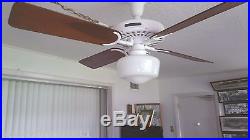
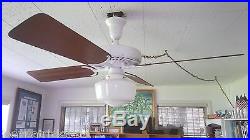
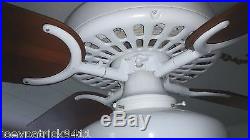
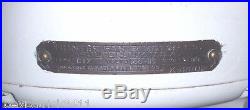


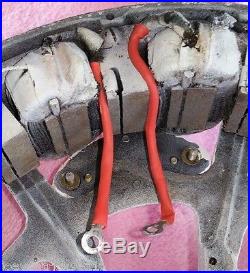
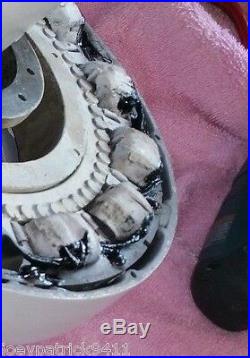

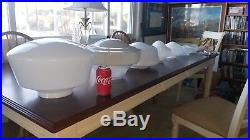
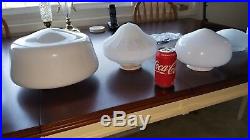
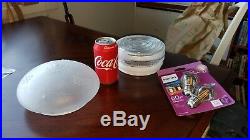

Perfect choice for restoring a home over 80 to 100 years old with a fan that would have been originally installed. The Hunter C-17 was produced from 1917 to 1933 and would be the correct Hunter Ceiling Fan for a home built in that time frame. If your home was built in New York during that time, you could take extra pride it was made in your home state. As such we come across fans from 1906 to 1960 in need of minor restoration. The fan shown in white is just one of the many options we have for finishing the 100-year-old C-17. The options below represent the factory options available from Hunter from 1917 to 1990. Bottom plate & blade arms & canopy with matching color or in brass or decorative brass bottom plate. Speed Control switch on the bottom. Reversible blade brackets that allow direction of air flow to go up or down. Length & color of the downrod bar and type of mounting system. Light fitter Options include. The last 3 photos show the 4″ & 6″ light fitters available with this fan. The 4″ & 6″ designation refer only to the mounting opening NOT the size of the globe. They are all 6″ except the 2 in the middle photo are 4″. The last photo shows the small 6 that require low profile bulbs. All of our restored fans come with a 5-year guarantee to run smooth, quiet and trouble-free. But honestly, they are restored like new and the quality is such that they will easily run another 100 years. FAN HAS BEEN COMPLETELY GONE THRU AND REFINISHED. We have 2 in stock and can refinish in the color of your choice. IT IS READY FOR ANOTHER 100 YEARS. Because it is finished in white, it is very easy to recoat in your choice of color. Simply sand it down with fine sand paper and apply 2 light coats of your choice. Use make offer option and mention your do it yourself option. DISASSEMBLED ONLY TO VERIFY NO ELECTRICAL SHORTS AND DO BASIC CLEANING & REFINISHING. You will notice the last 2 photos show some electrical enhancements. The two wires you see with the red sheath on them are the main lead in wires to the coils. Originally the wires were crammed between the metal coils & the frame with 95 year old paper insulators that posed a very possible shorting hazard. I put the heavy shrink wrap around them and made some additional clearing so they are now well insulated and no longer crammed into place. The other 96 yr old paper insulators between each coil in the last photo were removed and the wires were coated with liquid electrical tape along with the metal frames near each wire. They are well spaced away from the metal frame so they never posed any shorting hazard at all, the liquid electrical tape is only an additional precaution. All solder joints between each coil were good and strong and nothing further was necessary. Shorting wires is what causes the high current that can burn up coils, but other than that there is no reason these coils should not last another 100 years, provided you do not get hit with a direct lightning strike. Guaranteed to arrive as stated, as shown in good working condition. Reasonable offers considered, lowball offers automatically rejected. THIS C-17 STYLE FIRST APPEARED IN 1917, 102 YEARS AGO! The style was such a classic it has endured to this day. A note to all the so-called experts who will say black was the only color in 1917. Yes this fan has been repainted but white was ITS ORIGINAL COLOR- A Hunter option in 1917. Besides all that, it looks so much better than black in my opinion. We saw only white when refinishing the fan so we have every reason to believe that is the color. Drawing only 100 watts on high it is also like the “modern” Energy Star high-efficiency fans (except more CFM). Yes, that is right, a “modern” fan built over a 100 years ago! When it comes to 100-year-old American products that are still being used on a. Regular basis this fan has no match. Oh sure there are a few 100-year-old machines and cars around in museums but I said American made being. Used on a regular basis by a company still in business making the same type of item? Only Hunter Can make that claim. I challenge you to name me any other 100-year-old American product still used on a regular basis and the company is still in business making the same item. I might add, this fan moves a lot of air, more CFM than many new “Energy Star Rated” fans and its current draw is only about 100 watts on high. If one fan could be considered the fan called the Granddaddy of the Hunter line, it could be argued that this is it. The Hunter C-17 was without a doubt the workhorse for the company in the 1920s and early 30s. No other fan is most likely as recognizable through the decades as this one model and its offspring. Its popularity encouraged Hunter to continued to make similar models through the decades that followed. The Hunter R-52 and H-52 models are direct descendants of the C-17. You might recognize similar style models that Hunter has marketed in the past 35 years that looks similar, but not exact to the C-17. The C-17 is interesting in that they made the model in the standard style as shown and also offered it, at least for a short while in an ornamental style that featured grape leaves and vines highlighting its bottom plate and side ornaments. Probably the most famous company to label this model with their own badge was the Western Electric Company. Some of the features of this model include. Dimensions- 10″ length x 12″ diameter. Cast Iron Frame and Motor Housing. Oil Bath Lubrication System Continuously Bathes the Motor Shaft in a Curtain of Oil. Thrust Bearing Design is Immersed in Oil at All Times. The Granddaddy of the Hunter Line. Feel free to contact Jacob with any questions eight one three 5 O 6 O 7 6 2. The Memphis-based company produces more than 300 residential, commercial, and industrial ceiling fan models under such names as the 1886 Limited Edition, the Hunter Original, the Seville, and the Fantasy Flier. Accounting for nearly one percent of the room air conditioner market, Hunter has manufacturing operations in Memphis as well as in Mexico and the Far East. The Hunter Fan Company was founded in 1886 in Syracuse, New York, by James C. Hunter and his father, John Hunter, immigrants from Ireland. Originally known as the Hunter Fan and Ventilating Company, the fledgling business first engaged in the manufacture of water motors and meters. The founders expanded their operations to include the production of belt-driven fans, the power for which was first provided by water motors and later by the Tuerk Electric Motor, which they developed. The Hunter reputation for quality was established early in the company’s history: some of these earliest belt-driven fans are still in use today after more than a century. In 1889 the growing company moved its operations to Fulton, New York, where it would spend the next fifty years at a plant located at Front Street, extending from Huling Street to Tolbot Street. Twelve years later, upon the death of John Hunter, his six sons incorporated the company and focused their attention on expanding the production of ceiling fans. By the early 1920s, the company was widely known for its high-quality electric fans. Noted for their elaborate “Dragon” design, the electric fans were best suited for ceilings from ten feet and up and were advertised as ready for electric lights. By the early 1920s the Hunter name was widely known throughout the United States and the world. The fans were especially popular in India and China, and throughout the Far East, where thousands were exported each year. By the mid-1920s, desk oscillating fans had been added to the Hunter product line. In 1936, after purchasing the fan division of Century Electric Company, Hunter began manufacturing large pedestal air circulating fans and direct exhaust fans as well, which were used by many of the finest hotels and stores. Two years later, the company began producing attic fans as well. With the onset of World War II, the company suspended the manufacturing of ventilating equipment for consumer use and concentrated its efforts on aiding the war effort, producing belt fans for government use in Army hospitals and barracks, and portable ventilators and oscillators for the Navy. With the postwar boom in the U. Economy, Hunter expanded its operations to keep up with the growing need for commercial and industrial ventilating equipment. In 1946 the company moved its plant from Fulton to its present location in Memphis in order to take advantage of the rapid industrial expansion of the South. Three years later, Hunter was acquired by Robbins & Meyers, Inc. For the next 45 years, Hunter operated as a wholly owned subsidiary of Robbins & Meyers, producing a complete line of residential, commercial, and industrial fans. Although Hunter performed consistently well throughout the 1960s and 1970s, by the mid-1980s the company’s limited line of ventilating products, combined with the entrance of a number of new competitors into the market, brought on financial crisis. Clouspy, who took over as company chairman and chief executive officer. During the two years following the takeover, the management team guided the company through the financial crisis, developing a strategy of product diversification that made Hunter profitable once again. Solidifying its financial base by refinancing its remaining debt, Hunter was now in position to expand its operations through acquisition. A designer and importer of residential lighting products. In June 1987, the company went public under the name Hunter-Melnor, Inc. The company’s renewed success was attributed in part to the management style of Clouspy and his colleagues, who opted for a highly decentralized team of four presidents, each responsible for one division of the company. As Hunter was expanding its operations during this period, the company again underwent an organizational change. In 1988, just a year after it had gone public, the company was privatized through a leveraged buyout led by the investment firm Leach McMicking. The transition, however, did not impede the turnaround of the company. Boosted by the strong performance of the Melnor group and its line of garden chemical products, the Hunter group was able to take advantage of the expanding fan market, landing four new major customers: Payless Cashways, Kmart, Wal-Mart, and Target. Fan sales, once limited primarily to the South, had extended throughout the nation. While Miami, for instance, represented Hunter’s top sales city in 1984, Phoenix headed the list in 1987, followed by Philadelphia and Chicago. Driven by these forces, fan sales jumped from 1.2 million units in 1980 to 16 million in 1987, the company’s one-hundredth year of operation. As Hunter-Melnor, led by president and chief executive officer G. Competing in a market driven by such volatile factors as the weather, new home construction, and remodeling, Hunter and the rest of the industry were especially vulnerable to the recessionary economy of the late 1980s and early 1990s. Nevertheless, Hunter continued its pattern of growth by focusing on the remodelling segment of the industry, where the demand for its upscale units represented the greatest potential for profit. While these strategies kept Hunter-Melnor at the forefront of the industry, the company’s profitable Hunter division was weighted down by debt affecting the entire company. To alleviate this problem and make each division bear the responsibility for its own debt, Hunter-Melnor was divided into two corporations in September 1991. Under the reorganization plan, Robert Beasely took over as the new president and chief executive officer of Hunter Fan. Kenroy International was placed under its control as a subsidiary. Less encumbered by debt, Hunter Fan was able to direct its attention and resources to advertising and product development. While continuing to emphasize the home fashion aspect of its ceiling fans, adding such models as the Fantasy Flier–a fan replica derived from a naval archival drawing of an F4U fighter plane&mdashø its product line, Hunter Fan launched the largest advertising campaign in the history of the industry. The company set the stage for its aggressive strategy in the summer of 1992 by reformatting its logo across all of its product lines, incorporating a new Hunter green color and introducing upscale packaging graphics. Starting in May 1993, the company began advertising a wide variety of its ceiling fans in 30-second prime time television spots and in such popular magazines as Newsweek and Sports Illustrated, in which two-page, four-color spreads appeared. The unprecedented advertisements emphasized both the multipurpose dimension of ceiling fans, showing their effectiveness in areas as diverse as the bathroom and the porch, and the economical advantages of the product, making the case that fans are a cost-effective alternative to air conditioning. In the summer of 1993, the company introduced more than a hundred new lighting fixtures, including models featuring weathered metal, colored glass, and textured finishes, strengthening its reputation as the leading supplier of upscale decorative fans. In October of that same year, the company added another potentially profitable market to its repertoire when the United States Food and Drug Administration approved its air purifiers as Class II medical devices. Accordingly, the company launched a national print ad campaign targeting consumers with ads in magazines such as Ladies Home Journal, Reader’s Digest, and Modern Maturity. Perhaps the company’s most innovative and publicized campaign began in February 1995, seven months into a major league baseball strike. Going against conventional wisdom, Hunter Fan unveiled a baseball-themed ceiling fan and introduced a nationwide “Why I Love Baseball” program, calling for baseball fans to write letters explaining why they cherish the national pastime. As an added incentive to the fans, the company awarded trips to the Baseball Hall of Fame in Cooperstown, New York, and ceiling fans to winners of the contest, which was judged by such well-known baseball fans as filmmaker Ken Burns, Sporting News editor John Rawlings, and the “Clown Prince of Baseball, ” Max Patkin. Instead of proving a liability, the strike actually succeeded in generating widespread interest in the contest and in the novelty item. With more than 225 U. Radio stations and a host of television stations and major publications covering the campaign, Hunter Fan was able to reap benefits from what may have first appeared to be a marketing disaster: in just the first few weeks of the campaign, the baseball fan became one of the company’s leading sellers. Behind the strength of its bold marketing strategy, Hunter Fan has entered its second century of operation well positioned for continued expansion. How far past this level the company will go depends largely on the state of the U. Construction market, the success of new competitors to the industry, and the height of the mercury on the thermometer. Track Page Views With. Auctiva’s FREE Counter. The item “100 YEAR OLD HUNTER C-17 ANTIQUE ELECTRIC 52 CEILING FAN-Restoration Hardware” is in sale since Tuesday, February 5, 2019. This item is in the category “Collectibles\Kitchen & Home\Electric Fans”. The seller is “jj-do-it-products” and is located in Tampa, Florida. This item can be shipped to United States, Canada, United Kingdom, Denmark, Romania, Slovakia, Bulgaria, Czech republic, Finland, Hungary, Latvia, Lithuania, Malta, Estonia, Australia, Greece, Portugal, Cyprus, Slovenia, Japan, China, Sweden, South Korea, Taiwan, Thailand, Belgium, France, Hong Kong, Ireland, Netherlands, Poland, Spain, Italy, Germany, Austria, Bahamas, Israel, Mexico, New Zealand, Singapore, Switzerland, Norway, Saudi arabia, United arab emirates, Qatar, Kuwait, Bahrain, Croatia, Malaysia, Uruguay, Barbados, Sri lanka, Macao.
- Country/Region of Manufacture: United States
- Country of Manufacture: United States



